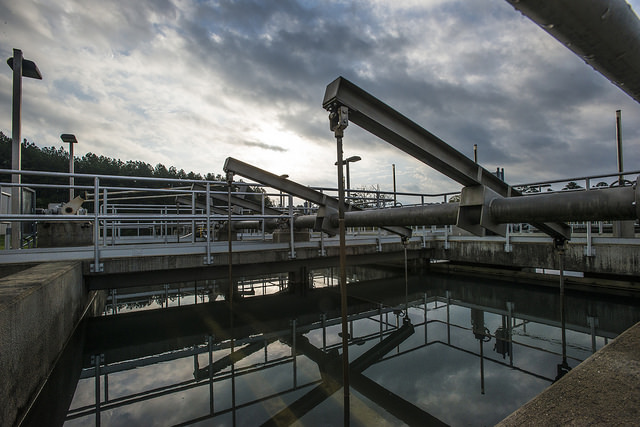

The United States has a PFAS problem. Whether they are raining down from the sky or popping up in food packaging, the mysterious chemicals, also known as Per- and polyfluoroalkyl substances have been finding their way into our bodies and environment—sometimes at concerningly high levels. PFAS are also found in everyday cosmetics, especially in longwear and waterproof makeup items and can accidentally be ingested overtime. PFAS can even be found in our drinking water.
PFAS are not only dangerous because they build up in the environment and in our bodies, but the chemicals are often associated with low infant birth rates and even cancer according to the EPA. In the past year, some research has connected high rates of PFAS exposure to worse COVID outcomes. Despite being such harmful toxins to people, they’re used regularly and are not historically regulated in the U.S.
To tackle this dilemma, the Environmental Protection Agency (EPA) announced a “Comprehensive National Strategy” to regulate the toxic industrial chemical. The plan describes three main strategies going forward–investing in more research on PFAS, leveraging authorities that can take action to restrict more PFAS chemicals from being released, and accelerating PFAS contamination cleanups. EPA administrator Michael S. Regan pointed out that the agency will work on holding polluters accountable in the announcement.
“This roadmap commits the EPA to quickly setting enforceable drinking water limits for these chemicals as well as giving stronger tools to communities to protect people’s health and the environment,” North Carolina Governor Roy Cooper said in the EPA’s announcement. “As we continue partnering with the EPA on this and other important efforts, the Bipartisan Infrastructure Deal and the larger budget resolution would provide critical help by dedicating significant resources to address PFAS contamination.”
[Related: Eco-friendly packaging could be poisoning our compost.]
The strategy includes setting aggressive water limits for PFAS to avoid future water contamination. PFAS manufacturers, like DuPont, a company that makes products like building equipment and agricultural chemicals, will have to self-report how toxic their products are. The EPA will also designate the forever chemicals as hazardous substances under the Superfund law, meaning that polluters will be held responsible for areas they contaminate and will have to pay for the cleanup themselves.
Alongside the EPA’s roadmap strategy, the Food and Drug Administration will also expand testing of the food supply to help estimate how people in the country are exposed to PFAS through their diet. The Agriculture Department will also boost its own efforts to address PFAS contamination in the nation’s food alongside the FDA and EPA, the Associated Press reported.
This report comes soon after the EPA identified more than 120,000 locations around the US where people may be exposed to a class of toxic “forever chemicals”. According to The Guardian, there doesn’t seem to be any part of the country where people are not exposed to these dangerous chemicals.
Pat Parenteau, an environmental law professor at Vermont Law School says the announcement is welcome after what he considers years of neglect from the Obama and Trump administration. More could have done more to regulate the dangerous chemicals, he says, and the agency should act quicker on banning PFAS and enforcing cleanup.
“Health experts have been warning for years [that] this entire class of synthetic organofluorine chemicals pose a threat and should be regulated accordingly,” he says. “The EPA has authority under the Toxic Substances Control Act to suspend and even ban large categories of these chemicals especially those used in nonessential products like cosmetics and pizza boxes. It should accelerate that process using its own labs rather than asking the manufacturers for more information and waiting years for the results.”
[Related: ‘Forever chemicals’ could be lurking in your lipstick.]
Parenteau also argues that the EPA should designate PFAS chemicals as hazardous substances under the Superfund law to help accelerate their cleanup from the environment.
“[This should target] particular military installations which are major sources of groundwater contamination. DOD also needs to make these cleanups a priority and move more quickly to develop alternatives for fire-fighting foams,” he said. “We need a warp speed response to get in front of this health emergency.”
Michael R. Blumenthal, an environmental law attorney at corporate defense litigation law firm McGlinchey Stafford is also disappointed that the EPA did not announce stronger restrictions on PFAS. He predicts that many states will create their own restrictions that may be even more aggressive than the EPA’s roadmap. Blumenthal also predicts future litigation against the agency and private companies that have exposed individuals to PFAS.
“[It looks like the EPA is] waiting for 2022 and there’s going to be a lot of time between now and 2022 that is going to potentially expose people to cross contamination in drinking water, ” he says.
Blumenthal also pointed out that the EPA’s announcement is similar to a 2019 announcement that also promised to research PFAS contaminations in hopes of implementing stricter regulations for public safety.
“You have to treat [PFAS] like asbestos… they’re not doing that,” he says. “It was like a lot of promises and ideas, and nothing concrete, and there’s nothing new. I don’t see this problem going away quickly.”























